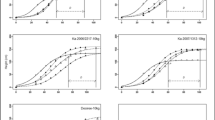Abstract
Wheat,Triticum aestivum L. cv. Mexipak was artificially inoculated withAnguina tritici (Steinb.) under field conditions. Nematode inocula: 0, 0.1, 0.2 and 0.3 g of seed galls/50 seeds or, germinated seeds of wheat (sown in a 1-m long row) were either added as intact seed galls or as a suspension of 2nd stage juveniles. Inoculation of ungerminated seeds with juveniles produced the highest incidence of ear-cockle disease. Whereas, intact seed galls inocula produced the highest incidence of tundu disease. Ear-cockle incidence was always greater than that of tundu at all treatments. The highest reduction in grain yield was associated with the treatments that caused the highest incidence of tundu disease.
Similar content being viewed by others
References
Al-Beldawi A, Stephan Z A and Alwan A H 1977 General survey of wheat seed gall disease in Iraq. Year book of Plant Protection Research 1, pp 237–267.
Al-Beldawi A, Stephan Z A, Alwan A H and Shali R A 1977 Studies on wheat gall nematode in Iraq. Year book of Plant Protection Research 1, pp 268–283.
Al-Sabie R F 1981 Biology and Histopathology of Different Isolates ofAnguina tritici onTriticum spp. PhD. Thesis. Univ. of London, 178P.
Bird A F 1981Anguina—Corynebacterium association.In Plant Parasitic Nematodes. V. III. Eds. B M Zuckerman and R A Rhode. pp 303–323. Academic Press, New York.
Cheo C C 1942 A note on the relation of nematodes (Tylenchus tritici) to the development of the bacterial disease of wheat caused byBacterium tritict. Ann. Appl. Biol. 33, 446–449.
Fattah F A 1986 Occurrence of spike blight (Tundu) disease on wheat in Iraq. Proc. 4th Sci. Conf. SRC, Baghdad, Vol. I, 1514–1519.
Saleh H M 1987 Standardization of inoculation technique. IX Scientific Conf., Iraqi Biol. Soc. 23.
Gupta P and Swarup G 1972 Ear-cockle and yellow ear rot disease of wheat. II. Nematode bacterial association. Nematologica 18, 320–324.
Kadu C I and Heskett M C 1970 Selective media for isolation ofAgrobacterium, Corynebacterium Erwinia, Pseudomonas and Xanthomonas. Phytopathology 60, 969–976.
Midha S K and Swarup G 1972 Factors affecting development of ear-cockle and tundu diseases of wheat. Indian J. Nematol. 2, 97–104.
Pathak K N and Swarup G 1984 Incidence ofCorynebacterium michiganenses P V.tritici in the ear-cockle nematode (Anguina tritici), galls and pathogenicity. Indian Phytopath. 37, 267–270.
Suryanarayana D and Mukhopadhaya M C 1971 Ear-cockle and ‘tundu’ disease of wheat. Indian J. Agric. Sci. 41, 407–413.
Author information
Authors and Affiliations
Rights and permissions
About this article
Cite this article
Fattah, F.A. Effects of inoculation methods on the incidence of ear-cockle and ‘tundu’ on wheat under field conditions. Plant Soil 109, 195–198 (1988). https://doi.org/10.1007/BF02202084
Received:
Revised:
Issue Date:
DOI: https://doi.org/10.1007/BF02202084




